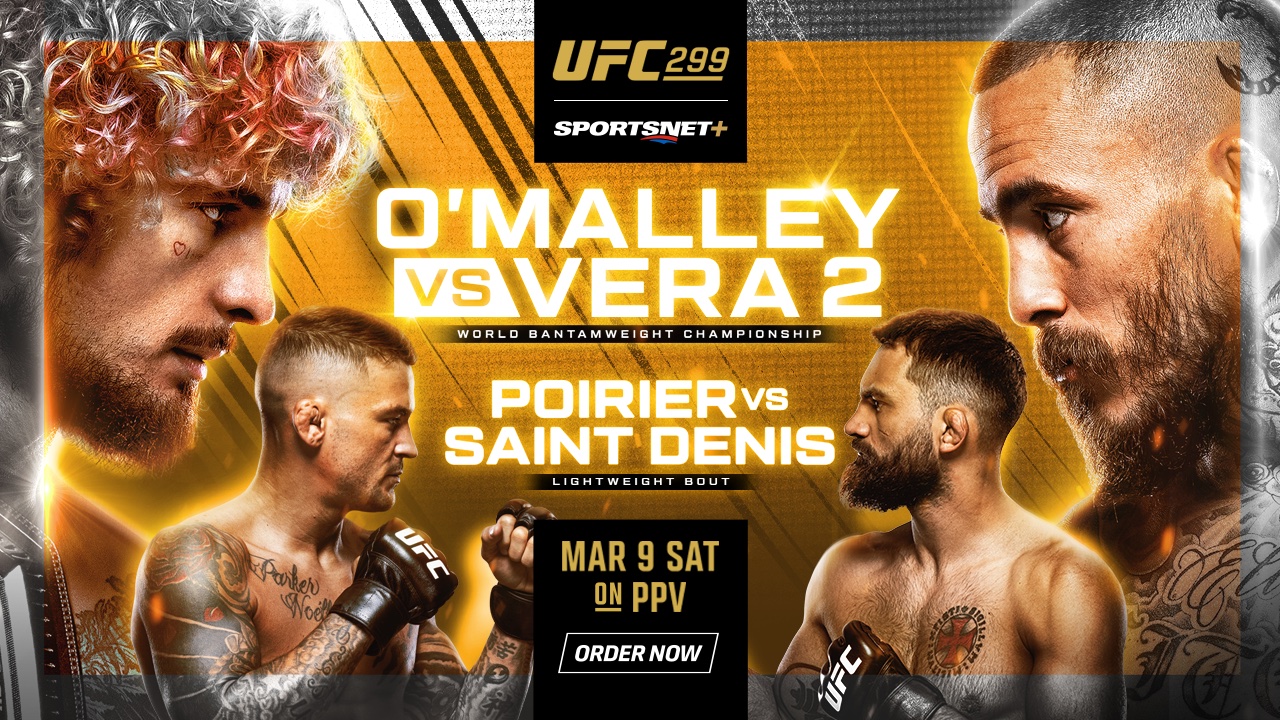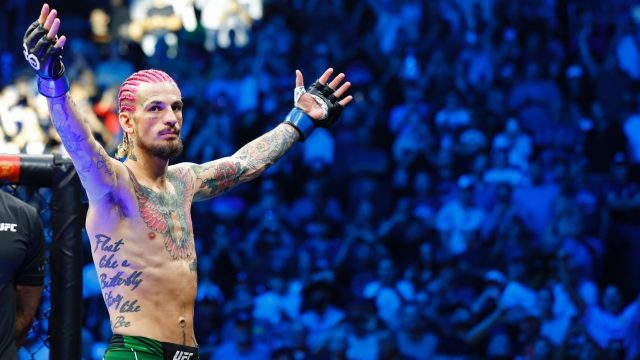“This card is absolutely stacked!”
We have heard that expression countless times in the lead up to a UFC card and with the trifecta of February’s UFC 298, Saturday’s UFC 299 and April’s UFC 300, we have three consecutive pay-per-view events loaded with high-level talent.
While the UFC 300 headliner of Alex Pereira vs. Jamahal Hill may have left something to be desired in a blockbuster main event without a household name that extends beyond the UFC bubble, there is absolutely no questioning the overall talent level featured on the milestone card from top to bottom.
Stacking a card will always satiate an audience hungry for high level mixed martial arts, but it raises two major questions, which are how it impacts the other cards on the UFC schedule and how it affects the viability of how each division progresses.
With that in mind, I compiled data based on every ranked UFC fighter (which includes champions), as well as each division’s top-10 fighters to see how much of the top athletes are being utilized during the five-month period beginning December 1 and ending April 30.
Top Talent Usage for Pay-Per-View Events
Based on my research, during this five-month time frame, the top-10 UFC fighters (champion and the next nine ranked) across all eleven weight classes have competed on pay-per-view events 61.4 per cent of the time, which accounts for just 29.4 per cent of the UFC’s events. That means that 38.6 per cent of top-10 fighters are being spread to the other 70.6 per cent of UFC cards during this time frame.
When looking at all ranked fighters, that percentage becomes 55.63 per cent on pay-per-view cards and 44.37 per cent on Fight Night cards, which shows the emphasis of top-10 fighters being utilized for pay-per-view cards, while those in the bottom six slots of each division’s rankings are often earmarked for Fight Night events.
Percentage of Bookings
One staggering figure was that in this five-month period, 77.27 per cent of the UFC’s ranked fighters have either competed, will compete or were scheduled to compete before having to withdraw, that number jumps to 81 per cent for top-10 fighters. March alone accounts for nearly 20 per cent of the UFC’s ranked fighters competing, with 45.7 per cent of them competing on pay-per-view. That number jumps to 52.4 per cent when narrowed to only the top-10 across the UFC’s divisions, meaning that 10 per cent of the UFC’s top-10 fighters compete on the UFC 299 card.
How stacked is UFC 300?
The month of April currently has 25 ranked fighters scheduled to compete. That is the second lowest monthly figure in this five-month sample behind January (20), which only had two events compared to the three scheduled for April.
The staggering number is that 19 of those 25 ranked fighters compete at UFC 300 (76 per cent) and of those 19 ranked competitors, 17 are specifically top-10 fighters. UFC 300 has 15.4 per cent of the roster’s top-10 fighters and 10.7 per cent of all ranked fighters across every division competing at the event. UFC 300 currently has 24 fighters scheduled to compete, which means about 71 per cent of the fighters on the card are in the top-10 of a division.
By comparison, UFC 300 has more top-10 ranked fighters on the card than UFC 200 did (15) when the organization crossed that milestone back in July of 2016.
Most And Least Utilized Weight Classes
If all these fights occur as scheduled, only three weight classes will not have had a championship bout from December through April.
Those weight classes are women’s flyweight and men’s lightweight and heavyweight, which do not have any title fights scheduled at the time this article was published.
In terms of ranked fighters and champions who competed or were scheduled to compete during this time, women’s bantamweight had 93.75 per cent of those ranked booked at the high end and heavyweight had only 37.5 per cent at the low end. The heavyweight division is a statistical anomaly, however, as the next lowest rate is strawweight at 68.75 per cent.
In total, 77.27 per cent of the UFC’s champions and ranked fighters across all divisions were either scheduled to compete or have competed during this five-month period.
Impact On Future Events
One of the arguments against stacked cards is the impact they can have on upcoming pay-per-views, which then lack options to draw from.
UFC 301, scheduled for May 4 in Rio de Janeiro for example, will be a tricky puzzle to solve for UFC brass.
With Alex Pereira, one of two current Brazilian champions, headlining UFC 300, the Brazil card will likely look to the other Brazilian titleholder, Alexandre Pantoja, to headline.
While that makes a lot of sense, it raises the question of who Pantoja will face. Those waters have proven to be very murky as of late, as the past two events had unconvincing showings in winning efforts from both Brandon Royval and undefeated prospect Muhammad Mokaev.
Royval’s win was against former champion Brandon Moreno, which gives him the best qualifications, however Pantoja’s most recent title defence came against Royval in something of an uncompetitive fight. Amir Albazi could end up being the challenger based solely on circumstances. No matter which way you slice it, you are left with a championship bout that is very difficult to market and expected to be lopsided.
Another issue is that the number of ranked Brazilians expected to be available for the card are short in number.
The only top-10 Brazilian fighters that could be available to compete in May are Matheus Nicolau, Johnny Walker, Natalia Silva, Mayra Bueno Silva, Ketlen Vieira and Viviane Araujo, unless both Paulo Costa and Jailton Almeida are open to quick turnarounds. This is a result of many of the top Brazilian fighters being booked for UFC 299 and UFC 300.
The UFC could also abandon the regional headliner strategy and have Leon Edwards defend the welterweight title, which would not mean much to the Brazilians fans in attendance, but would add some lustre for the pay-per-view buying audience.
The following month is UFC 302, expected to take place June 1 in Newark, N.J.
On that date, I would expect more options to be available, including lightweight champion Islam Makhachev, which would result in a quick turnaround for potential challengers Charles Oliveira, Arman Tsarukyan and Justin Gaethje, all of whom compete at UFC 300. Other possible champions available would be Alexa Grasso, Raquel Pennington, Leon Edwards, Dricus Du Plessis and possibly an interim championship defence for Tom Aspinall.
The next event would be UFC 303 for International Fight Week at the end of June, where I expect Jon Jones vs. Stipe Miocic will headline that card.
Is Stacking Good?
It will be much easier to assess whether or not stacking these cards was worth it once UFC 301 and 302 are fully assembled. For the time being, it would be fair to argue that UFC 299 and 300 are perhaps the most star-laden back-to-back pay-per-views that we have seen in UFC history. A true showcase of MMA at the highest level with fights on both preliminary cards that could easily headline UFC Fight Night events.
This “book now, ask questions later” approach from the UFC is fan friendly and also gives their champions a semblance of negotiating power if options are dwindling for subsequent pay-per-view events.
These super cards will appeal to the masses and be can’t-miss events for even the most casual of MMA fans. The sacrifice comes for the diehard fans, who have to decide whether UFC Fight Night cards are worth their time if they lack name value or highly ranked fighters.









